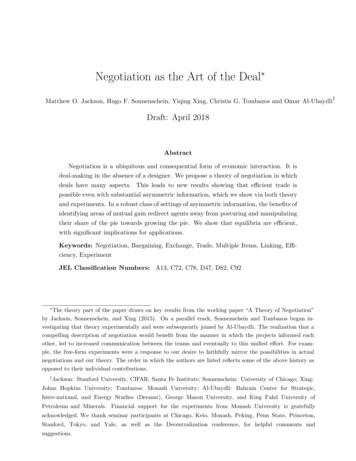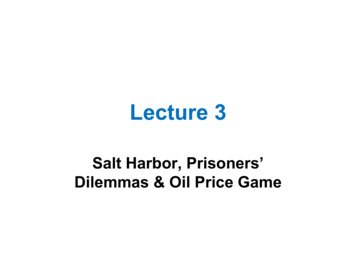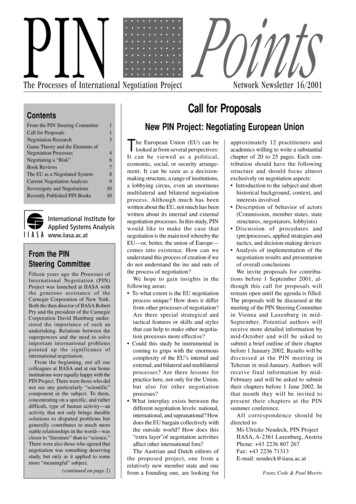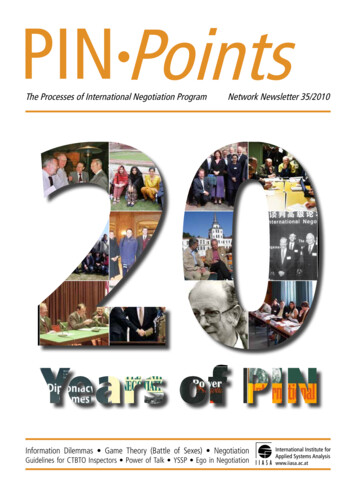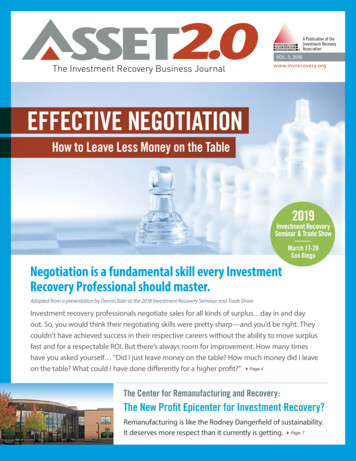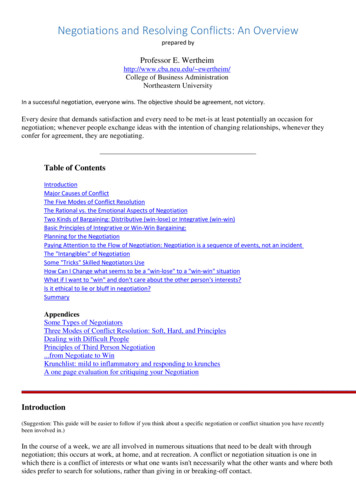
Transcription
Negotiations and Resolving Conflicts: An Overviewprepared byProfessor E. Wertheimhttp://www.cba.neu.edu/ ewertheim/College of Business AdministrationNortheastern UniversityIn a successful negotiation, everyone wins. The objective should be agreement, not victory.Every desire that demands satisfaction and every need to be met-is at least potentially an occasion fornegotiation; whenever people exchange ideas with the intention of changing relationships, whenever theyconfer for agreement, they are negotiating.Table of ContentsIntroductionMajor Causes of ConflictThe Five Modes of Conflict ResolutionThe Rational vs. the Emotional Aspects of NegotiationTwo Kinds of Bargaining: Distributive (win-lose) or Integrative (win-win)Basic Principles of Integrative or Win-Win Bargaining:Planning for the NegotiationPaying Attention to the Flow of Negotiation: Negotiation is a sequence of events, not an incidentThe "Intangibles" of NegotiationSome "Tricks" Skilled Negotiators UseHow Can I Change what seems to be a "win-lose" to a "win-win" situationWhat if I want to "win" and don't care about the other person's interests?Is it ethical to lie or bluff in negotiation?SummaryAppendicesSome Types of NegotiatorsThree Modes of Conflict Resolution: Soft, Hard, and PrinciplesDealing with Difficult PeoplePrinciples of Third Person Negotiation.from Negotiate to WinKrunchlist: mild to inflammatory and responding to krunchesA one page evaluation for critiquing your NegotiationIntroduction(Suggestion: This guide will be easier to follow if you think about a specific negotiation or conflict situation you have recentlybeen involved in.)In the course of a week, we are all involved in numerous situations that need to be dealt with throughnegotiation; this occurs at work, at home, and at recreation. A conflict or negotiation situation is one inwhich there is a conflict of interests or what one wants isn't necessarily what the other wants and where bothsides prefer to search for solutions, rather than giving in or breaking-off contact.
Few of us enjoy dealing with with conflicts-either with bosses, peers, subordinates, friends, or strangers.This is particularly true when the conflict becomes hostile and when strong feelings become involved.Resolving conflict can be mentally exhausting and emotionally draining.But it is important to realize that conflict that requires resolution is neither good nor bad. There can bepositive and negative outcomes as seen in the box below. It can be destructive but can also play a productiverole for you personally and for your relationships-both personal and professional. The important point is tomanage the conflict, not to suppress conflict and not to let conflict escalate out of control. Many of us seekto avoid conflict when it arises but there are many times when we should use conflict as a critical aspect ofcreativity and motivation.TopPotential Positive Outcomes of Conflict can motivate us to try harder-to "win"can increase commitment, enhance grouployaltyincreased clarity about the problemcan lead to innovative breakthroughs andnew approachesconflict can clarify underlying problems,facilitate changecan focus attention on basic issues and leadto solutionincreased energy level; making visible keyvaluesinvolvement in conflict can sharpen ourapproaches to bargaining, influencing,competingPotential Negative Outcomes of Conflict can lead to anger, avoidance, sniping, shouting,frustration, fear of failure, sense of personalinadequacywithholding of critical informationlower productivity from wasteful conflictcareers can be sidetracked; relationships ruinieddisrupted patterns of workconsume huge amount of time-loss of productivityYou will be constantly negotiating and resolving conflict throughout all of your professional and personallife. Given that organizations are becoming less hierarchical, less based on positional authority, less basedon clear boundaries of responsibility and authority, it is likely that conflict will be an even greatercomponent of organizations in the future. Studies have shown that negotiation skills are among the mostsignificant determinants of career success. While negotiation is an art form to some degree, there are specifictechniques that anyone can learn. Understanding these techniques and developing your skills will be acritical component of your career success and personal success.TopMajor Causes of ConflictOpposing interests (or what we think are opposing interests) are at the core of most conflicts. In a modern complexsociety, we confront these situations many times a day. The modern organization adds a whole new group ofpotential causes of conflict that are already present: competition over scarce resources, timeambiguity over responsibility and authority:
differences in perceptions, work styles, attitudes, communication problems, individual differencesincreasing interdependence as boundaries between individuals and groups become increasingly blurredreward systems: we work in situations with complex and often contradictory incentive systemsdifferentiation: division of labor which is the basis for any organization causes people and groups to seesituations differently and have different goalsequity vs. equality: continuous tension exists between equity (the belief that we should be rewarded relativeto our relative contributions) and equality (belief that everyone should receive the same or similaroutcomes).TopThe Five Modes of Responding to ConflictIt is useful to categorize the various responses we have to conflict in terms of two dimensions:1. how important or unimportant it is to satisfy our needs and2. how important or unimportant it is to satisfy the other person's needs.Answering this questions results in the following five modes of conflict resolution. None is these is "right"or "wrong". There are situations where any would be appropriate. For example, if we are cut off driving towork, we may decide "avoidance" is the best option. Other times "avoidance" may be a poor alternative.Similarly, collaboration may be appropriate sometimes but not at other times.Competition: Distributive (win-lose) bargainingSatisfying your needs is important; satisfying the other's needs isn't important to youCollaboration: Integrative (win-win)Satisfying both your needs and the other's needs is importantCompromising:Satisfying both your needs and the other's are moderately importantAvoiding:you are indifferent about satisfying either your needs or the other's needs: no action is likelyAccommodating:simply yield (it doesn't matter to you and it matters to the other person)In general, most successful negotiators start off assuming collaborative (integrative) or win-winnegotiation. Most good negotiators will try for a win-win or aim at a situation where both sides feel theywon. Negotiations tend to go much better if both sides perceive they are in a win-win situation or both sidesapproach the negotiation wanting to "create value" or satisfy both their own needs and the other's needs.We will focus on the two most problematic types: Collaborative (integrative)and Competitive (Distributive).Of the two the more important is Collaborative since most of your negotiation and conflict resolution inyour personal and professional life will (or should) be of this nature. This is because most negotiationinvolves situations where we want or need an on-going relationship with the other person. While it isimportant to develop skills in "competitive" bargaining (eg. when buying a car), or skills that allow us tosatisfy our concerns while ignoring the other's goals, this approach has many negative consequences for both
our personal lives and for our professional careers especially if we are to have an on-going relationship withthe other person.The key to successful negotiation is to shift the situation to a "win-win" even if it looks like a "win-lose" situation.Almost all negotiation have at least some elements of win-win. Successful negotiations often depend on finding thewin-win aspects in any situation. Only shift to a win-lose mode if all else fails.Reducing Conflict that Already ExistsOrganizations also take steps to reduce conflict. The following list suggests some of these ways: physical separationhierarchy (the boss decides)bureaucratic approaches (rules, procedures)integrators and third-party interventionnegotiationrotating membersinterdependent tasks and superordinate goals ("We are all in this together.")intergroup and interpersonal trainingTopRational vs. the Emotional Components of NegotiationAll negotiations involve two levels: a rational decision making (substantive) process and a psychological (emotional)process. The outcome of a negotiation is as likely to be a result of the psychological elements as it is the rationalelement. In most cases, the failure of two people to reach the "optimal" resolution or best alternative stems fromintangible factors such as:Psychological Factors that will affect negotiations how comfortable each feels about conflicthow each perceives or mis-perceives the otherthe assumptions each makes about the other and the problemthe attitudes and expectations about the otherthe decisions each makes about trust, about how important "winning" is, how important it is to avoidconflict, how much one likes or dislikes the other; how important it is to "not look foolish."Understanding the "rational" part of the negotiation is relatively easy. Understanding the "psychological" part ismore difficult. We need to understand ourselves and our opponents psychologically. Failure to understand thesepsychological needs and issues is at the root of most unsuccessful negotiations.This is made more difficult because norms in most organizations discourage open expression of negativepersonal feeings. Thus intense emotional onflicts are often expressed and rationalized as substnative issues.People often drum up disagreements on trivial issues to provide justification for an emotional conflict withanother individual (Ware and Barnes).Top
Basic Issues in Conflict Management what are the personal and organizational consequences of the conflictwhat are the behavioral patterns that characterize the conflictsubstantive issues vs. emotional issuesapparent underlying and background conditions leading to the conflictWelcome.TopThe Two Most Important Kinds of Bargaining: Distributive (win-lose) vs. Integrative(win-win)All bargaining situations can be divided into two categories:Distributive (also called competitive, zero sum, win-lose or claiming value).In this kind of bargaining, one side "wins" and one side "loses." In this situation there are fixed resources tobe divided so that the more one gets, the less the other gets. In this situation, one person's interests opposethe others. In many "buying" situations, the more the other person gets of your money, the less you haveleft. The dominant concern in this type of bargaining is usually maximizing one's own interests. Dominantstrategies in this mode include manipulation, forcing, and withholding information. This version is also called"claiming value" since the goal in this type of situation is to increase your own value and decrease youropponent's.Integrative (collaborative, win-win or creating value).In this kind of bargaining, there is a variable amount of resources to be divided and both sides can "win." Thedominant concern here is to maximize joint outcomes. An example is resolving a different opinion aboutwhere you and a friend want to go to dinner. Another example is a performance appraisal situation with asubordinate or resolving a situation of a subordinate who keeps coming in late to work. Dominant strategiesin this mode include cooperation, sharing information, and mutual problem solving. This type is also called"creating value" since the goal here is to have both sides leave the negotiating feeling they had greater valuethan before.It needs to be emphasized that many situations contain elements of both distributive and integrativebargaining. For example, in negotiating a price with a customer, to some degree your interests oppose thecustomer (you want a higher price; he wants a lower one) but to some degree you want your interests tocoincide (you want both your customer and you to satisfy both of your interests-you want to be happy; youwant your customer to be happy). The options can be seen in the table below:TopIntegrative or Win-Win Bargaining: The Critical Points Plan and have a concrete strategy: Be clear on what is important to youSeparate people from the problemEmphasize win-win solutions:Focus on interests, not positionsCreate Options for Mutual Gain: Generate a variety of possibilities before deciding what to do
Aim for an outcome be based on some objective standardConsider the other party's situation:Know your BATNA (Best Alternative to a Negotiated Alternative)Pay a lot of attention to the flow of negotiationTake the Intangibles into accountUse Active Listening SkillsTopDo some thinking ahead of time:Planning for the NegotiationBefore the negotiation it is helpful to plan. Know whether you are in a win-win or win-lose situation.Be sure of your goals, positions, and underlying interests. Try to figure out the best resolution you canexpect, what is a fair and reasonable deal and what is a minimally acceptable deal. What information do youhave and what do you need. What are your competitive advantages and disadvantages. What is the other'sadvantages and disadvantages. Give some thought to your strategy.It is very important to be clear on what is important to you. Be clear about your real goals and real issuesand try to figure out the other person's real goals and issues. Too many negotiations fail because people areso worried about being taken advantage of that they forget their needs. People who lose track of their owngoals will break off negotiations even if they have achieved their needs because they become moreconcerned with whether the other side "won."It is helpful to have a min-max strategy. Have a "walk-away" position. When entering a negotiation orconflict resolution, make sure you have already thought about answers to these questions: Planning for thenegotiation: The min-max approach1.2.3.4.5.What is the minimum I can accept to resolve the conflict?What is the maximum I can ask for without appearing outrageous;What is the maximum I can give away?What is the least I can offer without appearing outrageous?Try to predict the answers the other person will have to these questionsIt is important to know your competitive advantage-your strongest points. Also you need to know theadvantages to the other's argument. Similarly, know your weaknesses and the other's weaknesses.In most conflict resolution or negotiation situations you will have a continuing relationship with the otherperson so it is important to leave the situation with both sides feeling they have "won." It is very importantthat the other person doesn't feel that he or she "lost." When the other person loses, the results are often lackof commitment to the agreement or even worse, retaliation. The most common failure is the failure ofnegotiating parties to recognize (or search for) the integrative potential in a negotiating problem ; beneathhardened positions are often common or shared interests.Separate people from the problemAddress problems, not personalities: Avoid the tendency to attack your opponent personally; if the otherperson feels threatened, he defends his self-esteem and makes attacking the real problem more difficult;separate the people issues from the problem
Maintain a rational, goal oriented frame of mind: if your opponent attacks you personally, don't let him hookyou into an emotional reaction; let the other blow off steam without taking it personally; try to understandthe problem behind the aggressionEmphasize win-win solutions:Even in what appears to be win-lose situaitons, there are often win-win solutions; look for an integrativesolution; create additional alternatives, such as low cost concessions that might have high value to the otherperson; frame options in terms of the other person's interests; look for alternatives that allow your opponentto declare victoryFind underlying interestsA key to success is finding the "integrative" issues--often they can be found in underlying interests.We are used to identifying our own interests, but a critical element in negotiation is to come tounderstanding the other person's underlying interests and underlying needs. With probing and exchanginginformation we can find the commonalities between us and minimize the differences that seem to be evident.Understanding these interests is the key to "integrative bargaining." The biggest source of failure innegotiation is the failure to see the "integrative" element of most negotiation. Too often we think a situationis win-lose when it is actually a win-win situation. This mistaken view causes us to often use the wrongstrategy. Consider a situation where your boss rates you lower on a performance appraisal than you thinkyou deserve. We often tend to see this as win-lose-either he/she gives in or I give in. There is probably amuch higher chance of a successful negotiation if you can turn this to a win-win negotiation.A key part in finding common interests is the problem identification. It is important to define the problemin a way that is mutually acceptable to both sides. This involves depersonalizing the problem so as not toraise the defensiveness of the other person. Thus the student negotiating a problem with a professor is likelyto be more effective by defining the problem as "I need to understand this material better" or "I don'tunderstand this" rather than "You're not teaching the material very well."Use an Objective StandardTry to have the result be based on some objective standard. Make your negotiated decision based onprinciples and results, not emotions or pressure; try to find objective criteria that both parties can use toevaluate alternatives; don't succumb to emotional please, assertiveness, or stubbornessTry to understand the other person: Know his/her situationOften we tend to focus on our needs, our goals, and our positions. To successfully resolve conflict, it isimportant to focus also on the other person. We need to figure out what the other's goals, needs, andpositions are as well as their underlying interests. We need to think about the personality of the other person,how far we can push, how open or concealed we should make our positions.Acquire as much information about the other's interests and goals; what are the real needs vs. wants; whatconstituencies must he or she appease? What is her strategy? Be prepared to frame solutions in terms of herinterests.An important part of this is to recognize that people place very different values on issues than ourselves. Forexample, a clean room may be much more important to you than it is to your roommate. We mustunderstand how the other person sees reality, not just how we see reality.If through pressure, deception or sheer aggressiveness, we push people to the point where they seethemselves as likely to lose, this creates problems. The opponent will retaliate and fight back; losers often
lose commitment to their bargain. Also negotiators get reputations that can backfire. Remember thatsettlements which are most satisfactory and durable are the ones that address the needs of both parties.Know Your Best AlternativeTry to explore the other side's BATNA and certainly be aware of your own. See if you can change the otherperson's BATNA. If the other person's BATNA is poor (the alternatives to reaching an agreement with youare unattractive), you are in a better position.TopPaying Attention to the Flow of Negotiation:Negotiation is a sequence of eventsThere is a tendency to think about conflict or the negotiating situation as an isolated incid
negotiation; this occurs at work, at home, and at recreation. A conflict or negotiation situation is one in which there is a conflict of interests or what one wants isn't necessarily what the other wants and where both sides prefer to search for

